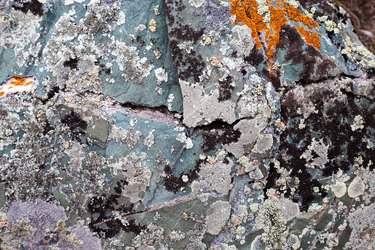
Black moss fungus is perhaps most well-known as an Asian vegetable. This food source is actually a terrestrial cyanobacteria, which means that it is a blue-green algae that grows in the soil. The popularity of black moss fungus – also known as fat choy or fatt choy – as a food source has led to some controversy concerning the environmental effect of its harvesting, as well as possible health concerns.
What is Black Moss Fungus?
Video of the Day
The scientific name for black moss fungus is Nostoc flagelliform, a member of the cyanobacteria family. Cyanobacteria contain chlorophyll and have photosynthetic capabilities, which make them more like a plant than a fungus. They are also one of the world's oldest known phototrophic organisms – plants that grow toward sunlight – whose origins date back about 2.5 billion years. The blue-green color of this organism in its natural state changes to black when the strands become dried out.
Video of the Day
Traditions of Fat Choy
The epicurean origins of black moss fungus are found in regions of Northern China, where this foodstuff grows abundantly. Black moss fungus is used especially in festivities related to the Chinese New Year, perhaps because of the fact that "fat choy" is part of a Chinese holiday greeting, kung hei fat choy, which translates to English as a wish for good luck or good fortune.
Traditional Chinese cuisine calls for soaking black moss fungi strands, which renders the strands into a vermicelli-like appearance, and then cooking the batch with fish belly and mushrooms to be served during the Chinese New Year festivities. Black moss fungus, or the fatt choy plant, is sold dried, and when cooked, it acts as a flour-like thickener to a sauce. Cooking black moss fungus gives it a seaweed-like, briny flavor.
Black Moss Fungus Environmental Concerns
The extensive and continuous harvesting of black moss fungus has had some negative environmental impact, according to an article in the Toronto Star. Black moss fungi is found to grow naturally in inner Mongolia and northwest China. In order to harvest this fungus, however, a lot of land needs to be dug up, and this destroys the vegetation that grows in this arid region of the world. Not much grows back, and this brings on erosion and causes sandstorms.
This damage occurs because black moss fungus grows up to 3 feet deep in the ground. Harvesting it causes some damage to the substrate and makes the soil vulnerable to water and wind erosion.
Black moss fungus harvesting is banned in China. It is listed as a conservation concern in Hong Kong, where it is no longer served at official events.
Black Moss Fungus Health Concerns
Although black moss fungus was once touted in Chinese lore for black moss health benefits, research studies have found that instead, black moss fungus as a food presents some serious health risks. Not only does it contain almost no nutritional value, it contains a toxic amino acid, beta-Methylamino-L-alanine (BMMA) that is linked with degenerative diseases such as Alzheimer's, Parkinson's, and other forms of dementia.
Black moss fungus is considered to be indigestible. Babies, young children and pregnant women are advised to consume black moss fungus in limited quantities.